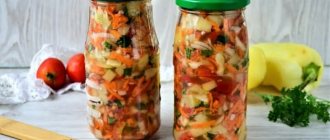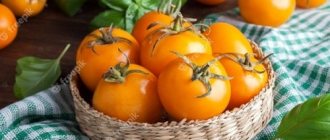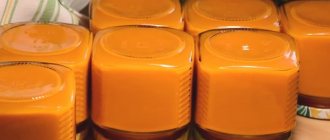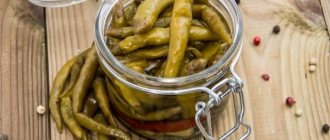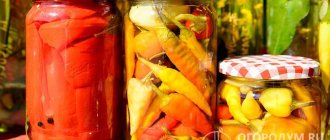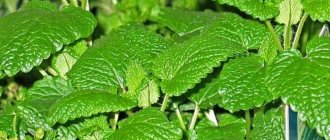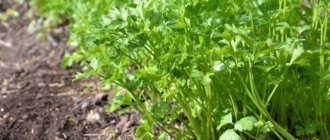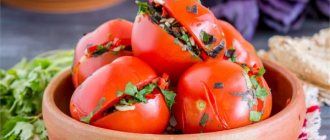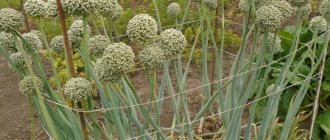You can prepare not only vegetables and fruits for the winter. Lovers of fresh and aromatic herbs, for example, can easily preserve their favorite herbs and roots. Take at least parsley. With proper processing, it can be perfectly stored all winter, retaining most of its beneficial properties. This is exactly what will be the topic of this story. So, harvesting parsley for the winter at home. By the way, you can use canned greens to prepare the same dishes as fresh greens.
Classic recipe for parsley with salt in a jar
Parsley prepared in the classic way with salt is easy to store. The jars do not take up much space, the contents do not ferment, the aroma and color are preserved, and most importantly, the greens can easily withstand the whole winter.
Parsley for the winter in the form of preparation. Classic recipe
What ingredients will you need?
For the preparation you need to take:
- parsley – 300 g;
- rock salt – 100 g.
Step-by-step cooking process
The cooking process includes several stages:
- It is necessary to thoroughly rinse the parsley so that no soil fragments remain on it.
- Next you need to trim the roots, if any. Using a sharp knife, carefully chop the greens.
- As you chop the parsley, it is recommended to transfer it to a deep container, evenly sprinkling it with coarse salt. When the ingredients run out, you need to mix the contents of the container thoroughly.
- Then you need to transfer the greens with salt into jars and compact them well.
- Next, you should put the filled jars in the refrigerator for 1-2 days. There is no need to close the jars with lids.
- After waiting the specified time, you need to remove the jars from the refrigerator and compact the contents tightly again. For better compaction, you can transfer greens from other jars.
- Tightly sealed jars of salted parsley should be stored in a cool place.
Important: when using greens, keep in mind that they are quite salty, so the dish can only be slightly salted or not at all.
Recommendations from experts
Parsley can be frozen with other herbs. So, suitable for salad:
- spinach;
- green onion;
- dill and parsley.
- Spinach is most often separated by hand so that it is not so big. It will be more convenient to use for storage and in winter.
- The best onion is the one that is picked young. From it you need to cut off a few centimeters of the green part of the grass (1-2 cm), cut off the tip of the fruit, and then rinse thoroughly. Onions will retain their bitterness if frozen quickly.
- Dill requires virtually no processing, except for its stems. They should be trimmed a little.
All these herbs need to be divided into small portions into bags and compacted thoroughly. With each frost, greens will lose their beneficial properties. Keep this in mind when you start dividing your grass!
When defrosting, the last cold item to be added will be the onion. You can cut it a little before you start laying out the greens. In winter, defrosted grass will be a good addition to a delicious summer dish.
Freezing is suitable for hot and cold foods. For both, you need to defrost it a little first. Then add in portions just before cooking. In soups, parsley will be combined with other ingredients. Salad with this herb is a traditional dish. Freeze greens using proven recipes! Bon appetit!
Freezing parsley
Parsley for the winter (prepared recipes are described later in the article) can be frozen in several ways.
When frozen, all vitamins, micro- and macroelements are preserved, which is very important in winter, when the lack of nutrients is especially acute. The only ingredient is parsley, but you can freeze it in several ways.
First way
A bunch of parsley should be washed and dried well. It is recommended to trim large stems, leaving only the leaves. Greens must be chopped at your discretion. Then you need to put it in a plastic bag and roll it into a “sausage” - this way it will be convenient to store it in the freezer.
The disadvantage of this method is that over time the greens will freeze. Foreign odors from other products tend to penetrate through cellophane.
They can absorb the smell of greens, and vice versa - the greens will absorb the smells of other products. To prevent this from happening, it is recommended to use alternative storage options. For example, plastic containers with lids are a great option. They fit conveniently in the freezer.
Another convenient option for storing frozen greens is a small plastic bottle with a wide neck. It is convenient to put greens in it, and it is also convenient to remove them from there. In addition, the container does not take up much space in the freezer. It is not recommended to compact the greens tightly.
Second way
This option involves freezing the greens in the form of ice cubes. The greens are prepared in the same way as described in the first method. Then you need to take ice molds, fill them with greens, compact them as tightly as possible and fill them with water.
After this, you should carefully place them in the freezer and wait until they are completely frozen. The finished cubes should be removed from the molds, transferred to a storage container, for example, a plastic bag, and used as needed. They are convenient to use when cooking first courses, adding 1-2 cubes to the pan to taste.
Third way
You can simply freeze a small bunch of parsley whole. The product frozen in this way is easily broken by hand or cut with a knife. The greens must be thoroughly washed and dried, collected in small bunches and frozen.
Then the frozen product is placed in plastic bags and stored in the freezer. Parsley frozen by any of the methods described above will be many times cheaper and healthier than that which is sold in winter, without losing its properties.
Freezing
Parsley can be prepared by freezing. The following methods are used for this:
- Bag – put the herb in vacuum or regular bags and put it in the freezer.
- In vegetable oil – chop the greens, loosely stuff them into a jar and pour in sunflower oil. Cover with a lid and refrigerate.
- In bunches – wrap the dried bunches in cling film and put them in the freezer.
- For the marinade, fill a sterilized jar with chopped herbs and add a hot solution of salt and water. You can seal it with a lid or roll it up and store it in the cold (cellar).
- In cubes – place the chopped parts of the plant in ice trays, add a little water and place in the cold to harden. Photos of finished cubes are not suitable for a magazine, but they are convenient to store.
You should follow some rules to properly harvest your grass. Recommendations:
- For freezing, it is better to chop the leaves and stems.
- Only dried, clean grass can be frozen.
- The plant should not be re-frozen.
- It is better not to use thick parts of the stem.
- For ease of use, it is worth freezing the herb in portions.
Preparing greens in oil
If there is enough free space in the refrigerator, or for some reason it is not possible to use the above methods, you can cook parsley with vegetable oil. It must be borne in mind that such preservation is stored only in the refrigerator.
What ingredients will you need?
For the preparation you need to take:
- green parsley – 450 g;
- Refined vegetable oil – as needed.
Step-by-step cooking process
The cooking process includes several stages:
- A bunch of parsley must be thoroughly washed and chopped. Then the greens need to be poured into a deep container.
- At the next stage, generously pour the greens with a large amount of vegetable oil and mix everything well.
- The finished mixture must be placed in washed jars and compacted as much as possible. The parsley should actually float in the oil.
- The jars must be tightly sealed and stored in the refrigerator.
Parsley for the winter (the preparations, the recipes of which are presented later in the article, are no more complicated than the previous ones), prepared using this method, are convenient to use when added to salads with vegetable oil.
Prepare the necessary ingredients
When collecting greens for storage, it is worth considering several rules under which parsley will retain maximum beneficial properties:
- The green part of the plants is collected at any time. The vitamin reserve concentrated in the leaves does not change during different periods of the growing season.
- The roots are collected only in the fall, since it is at this time that they are filled with the maximum amount of useful substances.
Before you start harvesting parsley, you need to separate the green part from the rhizome. Sort through all the leaves, removing dry, yellowed specimens.
Wash all components and dry well. Then decide on a method for storing it in the winter. It depends on the time available to the housewife and the personal preferences of family members.
Dried parsley for the winter
The simplest way to harvest this plant is drying. The greens must be washed, disassembled into inflorescences and laid out to dry. It is necessary to dry in the shade, for example, on a balcony or veranda. It is recommended to grind dried herbs using a coffee grinder or a regular blender. The finished seasoning can be poured into a spice jar and sealed tightly, used as needed.
The advantages of dried parsley lie in the versatility of this seasoning - it can be added to absolutely any dish. At the same time, no special conditions are required for storage; any dry place will do - for example, a kitchen cabinet bedside table.
Terms and conditions of storage
Parsley mixed with salt will retain its taste for 6 months. The workpiece will not deteriorate if you store it in a cool place - in a cellar, basement, insulated balcony or in the refrigerator. The temperature at the storage location should not exceed 7-8°C.
Dried herbs are stored in linen bags or paper envelopes in a dry place. You can also use jars with lids.
Advice. Check the workpieces from time to time to notice the appearance of dampness in time.
Parsley with garlic for the winter
Parsley and garlic seasoning belongs to Italian cuisine. Often, to enrich the taste of this seasoning, additional components are used - basil and lemon balm.
What ingredients will you need?
For the preparation you need to take:
- green parsley – 350 g;
- garlic – 7 heads;
- lemon – 1 pc.;
- salt - to taste, about 1 tbsp. l. no slide.
Step-by-step cooking process:
- The garlic must be peeled and disassembled into cloves.
- The lemon needs to be washed, cut into several parts and the seeds removed. There is no need to peel the peel.
- The greens need to be washed well; if there are roots, cut them off.
- Using a meat grinder you need to chop the parsley, lemon and garlic.
- The finished mixture should be mixed and placed in jars, sealing them tightly.
This seasoning is stored in the refrigerator, tightly sealed. Parsley for the winter (recipes are presented in large quantities, so every housewife can choose the best option for herself) with garlic fits absolutely any dish. You can also simply spread this snack on bread.
Recipe for greens in marinade
Another popular way to prepare parsley for the winter is pickling. The cooking recipe is more complex than the previously described preparations, but the result is worth it.
What ingredients will you need?
For the preparation you need to take:
- parsley – 320 g;
- vinegar 9% – 85 ml;
- granulated sugar – 40 g;
- kitchen salt – 35 g;
- water – 500 ml;
- garlic – 4 cloves;
- bay leaf - to taste, usually 1-2 pcs.
Step-by-step cooking process
Algorithm of actions:
- The parsley must be washed well and finely chopped.
- Garlic should be passed through a garlic press or simply grated.
- After this, everything should be mixed, and the prepared mixture should be filled into pre-sterilized jars.
- Pour water, vinegar into the pan, add bulk ingredients and bay leaf.
- The resulting marinade must be brought to a boil and the process continued for 10 minutes.
- Without removing the pan from the heat, you need to pour the boiling marinade into the jars. You can use a ladle for this. You need to pour it very carefully, little by little, so that the jar does not burst due to temperature changes.
- Filled jars must be covered with lids and placed in a saucepan, having previously covered the bottom with a towel and filled with water to the level of the necks of the jars.
- You need to sterilize for 20 minutes over low heat.
- At the end of the process, you need to carefully remove the jars from the pan and roll them up.
- The rolled up jars should be turned upside down, set aside and wrapped in a warm blanket for 12 hours.
It is recommended to store pickled parsley in a basement or cellar. It perfectly retains most of its beneficial qualities, despite heat treatment.
Description of the plant
Garden or curly parsley. In Latin the name sounds proud and majestic - Petroselinum crisoum or Petroselinum sativum. It belongs to the well-known umbrella family, that is, Apiaceae. The plant is biennial. After sowing in the first year, it produces a rosette with beautiful root leaves. In the second year it blooms in June or July and later produces seeds. The lower stem leaves are double pinnate, with an ovoid shape. But the upper ones are trifoliate with vaginas. Let me note that there are currently two varieties of parsley – leaf and root. Leafy greens are grown to produce large quantities of juicy and nutritious greens. There will be a lot of branches, even if you constantly cut them off by lunchtime. Increasingly, a variety of curly parsley is being cultivated in dachas. Sometimes they call her curly - she’s so pretty! Leafy varieties have small roots. But for the root crop, you can use both “tops” and large root crops, the weight of which reaches from 100 to 150 grams. Small white-yellow flowers are located on long peduncles. They are collected in complex inflorescences, the so-called “umbrellas”. The fruit is a small greenish-brown two-seed, slightly laterally compressed, and contains many (up to 1000) tiny ribbed seeds. They can remain viable for three years. It happens that they fall into the ground in the same bed or are slightly blown away by the wind.
Red parsley sauce with tomato paste for the winter
The presence of a huge amount of vitamins and minerals in parsley makes it an indispensable component of your favorite sauces. It goes well with spicy ingredients, giving sauces a special piquancy. The most popular sauce prepared for the winter is adjika.
What ingredients will you need?
For the preparation you need to take:
- parsley – 500 g;
- garlic – 225 g;
- sweet pepper – 500 g;
- granulated sugar – 50 g;
- kitchen salt – 35 g;
- sunflower oil – 25 g;
- tomato paste – 150 g;
- ground red pepper – 3 tsp.
Step-by-step cooking process
Cooking algorithm:
- Parsley must be thoroughly washed and dried.
- The garlic needs to be peeled and disassembled into cloves.
- Sweet peppers need to be washed, the tails cut off and the seeds removed.
- Vegetables and parsley need to be chopped using a meat grinder.
- Then add bulk ingredients and sunflower oil to the vegetable mixture.
- Lastly, add tomato paste and mix.
- The finished adjika needs to be placed in jars and sealed.
Important! This adjika can only be stored in the refrigerator.
Although parsley sauce turns out to be quite piquant and interesting in taste, it can be varied with the help of various additional ingredients. For example, adding sour apples will give the sauce a pleasant sourness; adding tomatoes will enhance the tomato taste of adjika.
Fans of culinary experiments can add ingredients such as celery, dill, cilantro, and basil. These herbs will not only not spoil the taste of the sauce, but, on the contrary, will add uniqueness and piquancy to the classic taste of adjika.
Pickling greens
The recipe for pickling parsley for the winter has been tested by many generations. This method is simple and allows you to preserve all the benefits of the product for a long time.
Salt is an excellent, reliable preservative that prevents spoilage of the product by pathogenic microorganisms . Pickling is an affordable method of preserving vegetables and herbs and is often used. You only need two ingredients: parsley and salt.
For five parts parsley you need one part salt. Prepare the stems of the plant, sort, wash, and dry. Place a mixture of chopped parsley and salt into sterile jars (heated in the oven or steamed). Screw on the lids. Store in the refrigerator or cool cellar.
For pickling, you can prepare a mixture of parsley leaves and grated roots . It is prepared according to the same recipe. The container is not completely filled, as the mixture will give juice. Stored the same way.
This preparation is very convenient; when preparing dishes, you do not need to salt them, all the beneficial properties and qualities of the plant, taste and smell are preserved.
You can also prepare root parsley in this way. The shelf life of such a product, subject to temperature conditions, is about six months.
Adjika from parsley with horseradish leaves
Horseradish gives the parsley sauce a special kick. You can use grated root, but the sauce will be much softer and more tender if you use horseradish leaves.
What ingredients will you need?
For the preparation you need to take:
- green parsley - one large bunch;
- fresh dill - one large bunch;
- celery - one large bunch;
- horseradish leaves – 30 pcs.;
- garlic – 12 cloves;
- chili pepper – 220 g;
- salt - approximately 2 tsp;
- vinegar 9% – 2 tbsp. l.
Step-by-step cooking process
Cooking algorithm:
- Dill, celery and parsley should be washed under running water and dried.
- The pepper must be cleared of tails and seed pods, the garlic must be peeled and disassembled into cloves.
- Horseradish leaves should also be thoroughly washed and the dense core cut out of them.
- All products must be twisted through a meat grinder and mixed well.
- Next you need to add salt and mix thoroughly again.
- Then, in the center of the container with adjika, you need to make a small recess and pour vinegar into it, about 2 tablespoons, or to taste.
- The mixture should be allowed to brew for about half an hour. During this time, you can sterilize and cool the jars, or you can do this in advance.
- Pack the adjika into jars, seal and store in a cool place, optimally in the refrigerator.
The sauce turns out to be quite strong, so to soften the taste it is recommended to mix it with lemon juice and olive oil. Another option is to mix adjika from parsley and horseradish leaves with sour cream. This sauce is perfect for potatoes and meat dishes.
Canning
Preservation is one of the ways to prepare parsley for a long shelf life. Even a beginner will not have any difficulties with cooking. The main preservative in all recipes is vinegar.
To prepare the preparation you will need directly herbs, vinegar and salt.
Parsley is prepared as for all other recipes. Wash well and dry. Cut into pieces 5 centimeters long. Carefully place in jars, then prepare the brine. For 1 liter of water, 1 tablespoon of salt.
Add 2 tablespoons of 6% vinegar to the finished jars and fill with brine. Do not top up, leaving about 2 centimeters.
Place in a container for sterilization. Boiling time is approximately 10-15 minutes. When ready, the jars are rolled up and placed under a blanket or blanket until completely cooled.
Vitamin preparation with dill
Parsley goes very well with dill - both in terms of taste and in terms of vitamins and beneficial elements. These gifts of nature complement each other perfectly, so the best way to protect yourself from vitamin starvation in winter is to make a preparation of parsley and dill.
What ingredients will you need?
For the preparation you need to take:
- parsley – 250 g;
- dill greens – 250 g;
- garlic – 6-7 cloves;
- sweet pepper – 2 pcs.;
- olive oil – 250 ml;
- lemon juice – 4-5 tbsp. l.;
- salt – 1 tsp;
- ground black pepper – 1 tsp;
- hot pepper - to taste.
Step-by-step cooking process
Cooking algorithm:
- The dill and parsley must be thoroughly washed and chopped as desired, since they will then be crushed using a blender.
- The bell pepper needs to be washed and cut as desired, removing the seeds.
- Hot peppers also need to be cut arbitrarily; the main thing here is to have a sense of proportion and not to overdo it with this component.
- The garlic should also be peeled and divided into cloves.
- All of the above ingredients must be placed in a blender bowl and blended into a homogeneous mass. If you don’t have a blender, you can use a meat grinder with a fine mesh.
- The next step is to add olive oil, spices, salt and lemon juice.
- The whole mass needs to be mixed and filled into containers.
The vitamin preparation is stored exclusively in the refrigerator in tightly closed jars. Those who do not like spicy food can omit hot pepper from the recipe and vary the amount of garlic as desired. But here it is necessary to remember that the taste of the vitamin preparation with dill strongly depends on these components, so you should not neglect them either.
Other harvesting methods
In addition to pickling, there are several other ways to keep parsley fresh for many months.
Drying
You can dry parsley branches and roots. You can prepare it this way:
- in the oven;
- electric dryer;
- microwave;
- convection oven;
- naturally.
First, the greens are washed well with running water, then shaken off and laid out on towels. As soon as the moisture is absorbed into the material, the parsley is chopped randomly, removing coarse stems.
If a dehydrator or electric dryer is used for drying, the greens in whole or crushed form are placed on a tray and the temperature is set to 40-50°C or the “For Herbs” mode. Higher levels will lead to loss of vitamins.
Drying time depends on the power of the device, air humidity, the type of herbs and the method of cutting them. To ensure uniform drying, trays with material are swapped every 1.5 hours. On average, parsley is dried for no more than 5 hours. If the device has a good fan installed, the process will go faster.
Those who do not have an electric dryer can use an oven. Place the prepared parsley on a baking sheet lined with baking paper. The paper on which the greens are placed should not be oiled.
The baking sheet is placed on the top shelf, the heating temperature should be 45-50°C. It is advisable to leave the oven door ajar. Drying takes 5-6 hours, the greens need to be checked from time to time.
Reference. To speed up the process, chop the parsley and spread it on a baking sheet in a thin layer. Drying will take 1.5-2 hours.
The microwave is also suitable for drying parsley. Place the herbs on a flat dish lined with a napkin or on a paper plate. The oven is turned on at full power for 2 minutes. After the readiness signal sounds, the greens are inspected and, if necessary, the procedure is repeated. Housewives advise inspecting parsley every minute of drying.
Chopped parsley can also be dried using an air fryer. The grass and roots are placed in the equipment, its door is not closed to allow air circulation. The temperature is set at 40-45°C, the power is maximum. To dry the branches, 20 minutes are enough, for the roots it will take 40 minutes.
The easiest way to dry parsley without additional equipment is naturally in bunches or chopped form. The greens, washed and dried from moisture, are tied in bunches and hung with the foliage down in a ventilated room.
You can also spread the parsley, whole or chopped, on paper in a dry place. The thickness of the layer of greenery should be no more than 1 cm. The drying room should not be exposed to direct sunlight so that the grass does not turn yellow. To ensure uniform drying, the material is stirred from time to time.
Drying naturally can take 5-14 days depending on the type of greens, how they are cut and weather conditions.
Parsley root is thoroughly washed with a brush before drying. Then it is cut into thin circles or strips and placed in an electric dryer or oven. Drying naturally produces a dried product.
Freezing
Only parsley is suitable for freezing . It is harvested in bunches or in a crushed state, depending on the purpose. Whole sprigs of parsley are used to decorate dishes, and chopped parsley is used to prepare sauces.
To freeze herbs in a bunch, wash them thoroughly and dry them on a towel. Then they are laid out in portions into bags. Chopped parsley is frozen in the same way. The greens are cut into large or small pieces and stored in the freezer.
Important! Thawed greens quickly lose their appearance, so they should not be frozen in one large bag.
Experienced housewives have adapted ice cube trays for freezing parsley. This preparation is convenient to use - one cube is suitable for one serving of the dish. The finer the material is cut, the easier it is to place it in the mold. For convenient storage and use, you can add a small amount of water to chopped parsley.
If there is a lot of greens, they are crushed in a blender and then distributed into molds. It is important to remove all rough parts of the plant. This preparation is used for making smoothies and sauces.
In oil
Parsley frozen in molds can also be filled with vegetable oil. Preference is given to olive oil - it better preserves the aroma of greens.
Refined sunflower oil is also used to prepare parsley in jars. After the greens are washed, dried, chopped and tightly placed in containers, oil is added to them. It is important to fill it to the top of the jar. To better fill the container, shake it up and turn it in different directions. This will allow the oil to completely cover the greens in the jar and displace any air bubbles.
Pickling
Only parsley roots are suitable for pickling.
For the marinade you will need:
- 4 tbsp. water;
- 1 tbsp. 9% vinegar;
- 0.5 tbsp. Sahara;
- 1-2 tsp. salt;
- 4 cloves garlic, chopped;
- 2 bay leaves;
- 5-7 black peppercorns.
Instructions for pickling parsley:
- Pre-rinse the material and dry it.
- Cut into slices or cubes.
- Place in salted boiling water for 2-3 minutes.
- Drain in a colander.
- Place in ice water for 30 seconds.
- Drain the water and place the root into jars.
- Pour boiling marinade over.
Parsley roots for the winter
Parsley for the winter (prepared recipes tell how to prepare root greens in addition to leafy greens) is useful:
- it is used in the treatment of prostatitis;
- to solve problems with the gastrointestinal tract;
- to normalize blood sugar;
- as a diuretic.
Parsley root can reduce allergies, normalize vision, and improve the condition of blood vessels. However, it is contraindicated for pregnant women, as it can cause premature birth. In cooking, parsley root is used, like leaf parsley: as a spice.
The root is dried, crushed and then added to various meat and fish dishes, and is also used in the preparation of various sauces.
To prepare parsley root, you need to dig it up, cut off the tops, clean it of soil, wash it thoroughly and dry it slightly. Then it is recommended to put it in a plastic bag and put it in the refrigerator - for example, on the door. Thus, it can be stored for quite a long time.
As needed, parsley root can be taken out of the bag, cut off the required amount and used for its intended purpose. A small amount of root will perfectly replace greens when cooking broth. Also, the root can be used in small quantities in salads if the recipe requires green parsley, but for some reason it was not available.
Benefits and contraindications
An aromatic plant with rosettes of leaves and a thickened root is grown everywhere. Spicy herbs are used in all types of dishes, except sweet ones.
Traditional healers advise using parsley and medicines made from it for those who suffer from:
- edema of cardiac origin;
- kidney stone disease;
- inflammation of the bladder and prostate;
- digestive tract dysfunction;
- colic in the intestines.
A decoction of the leaves of the spicy plant helps stimulate appetite. Herbal infusions are used for dermatitis, psoriasis, vitiligo, and baldness. The leaves of the plant are applied to the sites of insect bites.
You can preserve the beneficial properties of the plant by preparing the grass for the winter.
Contraindications for use:
- diseases of the bladder, stomach, liver and kidneys in the acute stage;
- increased tone of the uterine muscles during pregnancy;
- exceeding the recommended dosage when preparing and consuming medicinal decoctions leads to dizziness, nausea, and vomiting.
How to use parsley in winter
The beneficial properties of parsley have been used in folk medicine. The ancient Greeks equated a handful of parsley to a handful of gold - this plant was so highly valued. And the Queen of France, Marie de Medici, considered parsley to be the strongest antidote and consumed it in huge quantities.
Parsley contains substances necessary for the human body:
| Vitamins | Useful microelements |
| B1 | calcium |
| B2 | potassium |
| C | phosphorus |
| PP | iron |
| K | folic acid |
| carotene | essential oils |
The dietary fiber present in the plant helps normalize digestion. It is in winter, when the body vitally needs vitamins and microelements, that parsley preparations make up for the lack of these substances. Dry or frozen parsley is an invariable attribute of any first course. Sauces containing parsley can add variety to any dish or side dish.
The presented recipes for preparing parsley for the winter are a great way to protect yourself and your family from winter vitamin deficiency, as well as complement the menu with excellent sauces that will not only give dishes a unique taste, but also bring great benefits to the body.
Author: Andrey Domnenko
